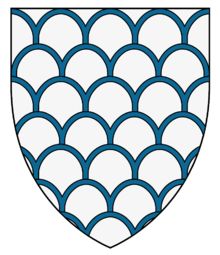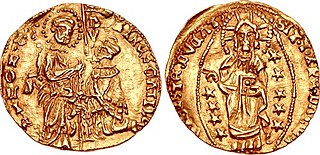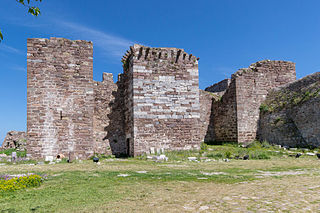Related Research Articles

Manuel II Palaiologos or Palaeologus was Byzantine emperor from 1391 to 1425. Shortly before his death he was tonsured a monk and received the name Matthew (Ματθαίος). His wife Helena Dragaš saw to it that their sons, John VIII and Constantine XI, became emperors. He is commemorated by the Greek Orthodox Church on 21 July.

Constantine XI Dragases Palaiologos or DragašPalaeologus was the last Byzantine emperor, reigning from 1449 until his death in battle at the Fall of Constantinople in 1453. Constantine's death marked the definitive end of the Eastern Roman Empire, which traced its origin to Constantine the Great's foundation of Constantinople as the Roman Empire's new capital in 330.

The House of Gattilusio was a powerful Genoese family who controlled a number of possessions in the northern Aegean from 1355 until the mid 15th century. Anthony Luttrell has pointed out that this family had developed close connections to the Byzantine ruling house of the Palaiologos—"four successive generations of Gattilusio married into the Palaiologos family, two to emperors' daughters, one to an emperor, and one to a despot who later became an emperor"—which could explain their repeated involvement in Byzantine affairs. The Gattilusi were Lords of Lesbos from 1355 to 1462 and Lords of Aenus from 1376 to 1456.

Demetrios Palaiologos or Demetrius Palaeologus was Despot of the Morea together with his brother Thomas from 1449 until the fall of the despotate in 1460. Demetrios and Thomas were sons of Byzantine Emperor Manuel II Palaiologos, and brothers of the final two emperors John VIII and Constantine XI. Demetrios had a complicated relationship with his brothers, whom he frequently quarrelled with, usually over the matter of Demetrios's wish to establish himself as the most senior of them and claim the imperial throne for himself.
George Sphrantzes, also Phrantzes or Phrantza, was a late Byzantine Greek historian and Imperial courtier. He was an attendant to Emperor Manuel II Palaiologos, protovestiarites under John VIII Palaiologos, and a close confidant to Constantine XI Palaiologos, the last Byzantine emperor. He was an eyewitness of the Fall of Constantinople in 1453, made a slave by the victorious Ottomans, but ransomed shortly afterwards. Sphrantzes served the surviving members of the Palaiologian family for the next several years until taking monastic vows in 1472. It was while a monk he wrote his history, which ends with the notice of Sultan Mehmed II's attempt to capture Naupaktos, which he dates to the summer of 1477; Sphrantzes is assumed to have died not long after that event.
Loukas Notaras was a Byzantine Greek statesman who served as the last megas doux or grand Duke and the last mesazon of the Byzantine Empire, under emperors John VIII Palaiologos and Constantine XI Palaiologos.

Thomas Palaiologos was Despot of the Morea from 1428 until the fall of the despotate in 1460, although he continued to claim the title until his death five years later. He was the younger brother of Constantine XI Palaiologos, the final Byzantine emperor. Thomas was appointed as Despot of the Morea by his oldest brother, Emperor John VIII Palaiologos, in 1428, joining his two brothers and other despots Theodore and Constantine, already governing the Morea. Though Theodore proved reluctant to cooperate with his brothers, Thomas and Constantine successfully worked to strengthen the despotate and expand its borders. In 1432, Thomas brought the remaining territories of the Latin Principality of Achaea, established during the Fourth Crusade more than two hundred years earlier, into Byzantine hands by marrying Catherine Zaccaria, heiress to the principality.

Theodore II Palaiologos or Palaeologus was Despot in the Morea from 1407 to 1443 and in Selymbria from then until his death.

John IV Megas Komnenos was Emperor of Trebizond from 1429 until his death. He was a son of Emperor Alexios IV of Trebizond and Theodora Kantakouzene.
Centurione II AsanesZaccaria, scion of a powerful Genoese merchant family established in the Morea since the marriage of the lord of Chios Martino Zaccaria to the baroness Jacqueline de la Roche. Centurione purchased the rights of the title of Prince of Achaea by Ladislaus of Naples in 1404 and was the last ruler of the once Latin Empire not under Byzantine suzerainty.
Irene Gattilusio was a Byzantine empress consort by marriage to John VII Palaiologos, a Byzantine Emperor in 1390. She was a daughter of Francesco II of Lesbos and Valentina Doria.

Francesco II Gattilusio was the second Gattilusio lord of Lesbos, from 1384 to his death. He was the third son of Francesco I Gattilusio and Maria Palaiologina, the sister of the Byzantine emperor John V Palaiologos.

Dorino Gattilusio was the fourth Gattilusio Lord of Lesbos from 1428 until his death. He ruled Lesbos at a time of increasing Ottoman power, and his last years were preoccupied with maintaining some measure of independence.
Sophia of Montferrat was a Byzantine empress by marriage to John VIII Palaiologos.
Eudokia Megale Komnene, was a Trapezuntine princess and a member of the powerful Byzantine Komnenos dynasty as a daughter of Emperor Alexios III of Trebizond.
Andronikos Palaiologos Kantakouzenos was the last Grand Domestic of the Byzantine Empire. Present in the city at the Fall of Constantinople in 1453, he was one of the group of high Imperial officials executed by Ottoman Sultan Mehmet II five days after the city was taken.
George Palaiologos Kantakouzenos was a Byzantine aristocrat, a member of the Kantakouzenos family, and adventurer. He is also known by the Turkish nickname Sachatai, which he earned in the service of the Despot Constantine early in his military career.
Helena Palaiologina, known also as Helena Hatun, was the daughter and only child of Demetrios Palaiologos, Despot of Morea, a brother of the final Byzantine emperor Constantine XI Palaiologos. Her mother was Theodora Asanina of the Asen family, a family which had once ruled Bulgaria. Famous for her beauty, Sultan Mehmed II, who had conquered Constantinople in 1453, took her into his harem after his conquest of the Morea in 1460, but soon decided to leave her in province, possibly due to fear of being poisoned by her.

The Ottoman conquest of Lesbos took place in September 1462. The Ottoman Empire, under Sultan Mehmed II, laid siege to the island's capital, Mytilene. After its surrender, the other forts of the island surrendered as well. The event put an end to the semi-independent Genoese lordship that the Gattilusio family had established in the northeastern Aegean since the mid-14th century, and heralded the beginning of the First Ottoman–Venetian War in the following year.
Asenina Palaiologina was the wife of Centurione II Zaccaria, one of the last Princes of Achaea (1404-1429) and after her marriage, she became consort of the Latin Principality.
References
- ↑ Donald M. Nicol, The Immortal Emperor (Cambridge: Canto Paperbacks, 1994), p. 17
- ↑ Nicol, Immortal Emperor, p. 18
- ↑ The Fall of the Byzantine Empire: a Chronicle by George Sphrantzes, 1401-1477, translated by Marios Philippides (Amherst: University of Massachusetts, 1980), p. 53